Art, design and architecture are autonomous disciplines that often influence and contaminate each other, each maintaining its own identity and purpose. The roles of the artist, the designer and the architect, differ in their approach and goals. The designer creates objects that must meet specific needs, objects that can be used and are often mass produced, industrially. The architect designs spaces or buildings, modifies places to fit the needs of those who are to use them. An artist has different needs. The ’artist makes works of art that may have aesthetic, cultural and social value.
What might result from a connection between art design and architecture? What could an artist, of a free-wheeling nature, achieve when he or she is instead obliged to follow rules of functionality and ergonomics, proportions and measurements? What could happen if artists created objects that were not just works of art, but elements of the home, objects that had function and could be used every day? Thanks to the insight and drive of visionary and extraordinarily far-sighted women and men, we can analyze some examples in which art architecture and design come together in perfect harmony. We cannot simply call them collectors; they are people out of the ordinary who have dedicated their lives to art and artists, with whom they have shared emotions and projects and established deep friendships, intimately knowing their work and creating authentic bonds. The insight of these figures drove the artists to create something unrepeatable. It is not a work of art, nor is it simply a design object or architecture. It is something that encompasses art, design and architecture. When the boundaries are thin, everything is intertwined and unexpected connections arise, resulting in unique creations.
Marguerite, known as Peggy, Guggenheim, represents a focal point in 20th-century art between the United States and Europe. Born in New York in 1898, she was heiress to two important families of the time: on her mother’s side the Seligmans, famous bankers, and on her father’s side the Guggenheims, owners of numerous copper mines. Daughter of Benjamin, who died tragically in the sinking of the Titanic, and granddaughter of Solomon, later founder of the Guggenheim Museum in New York. In her twenties she inherited not only a large sum of money, but also a passion for art and and patronage, passed on to her by her father, also a collector.
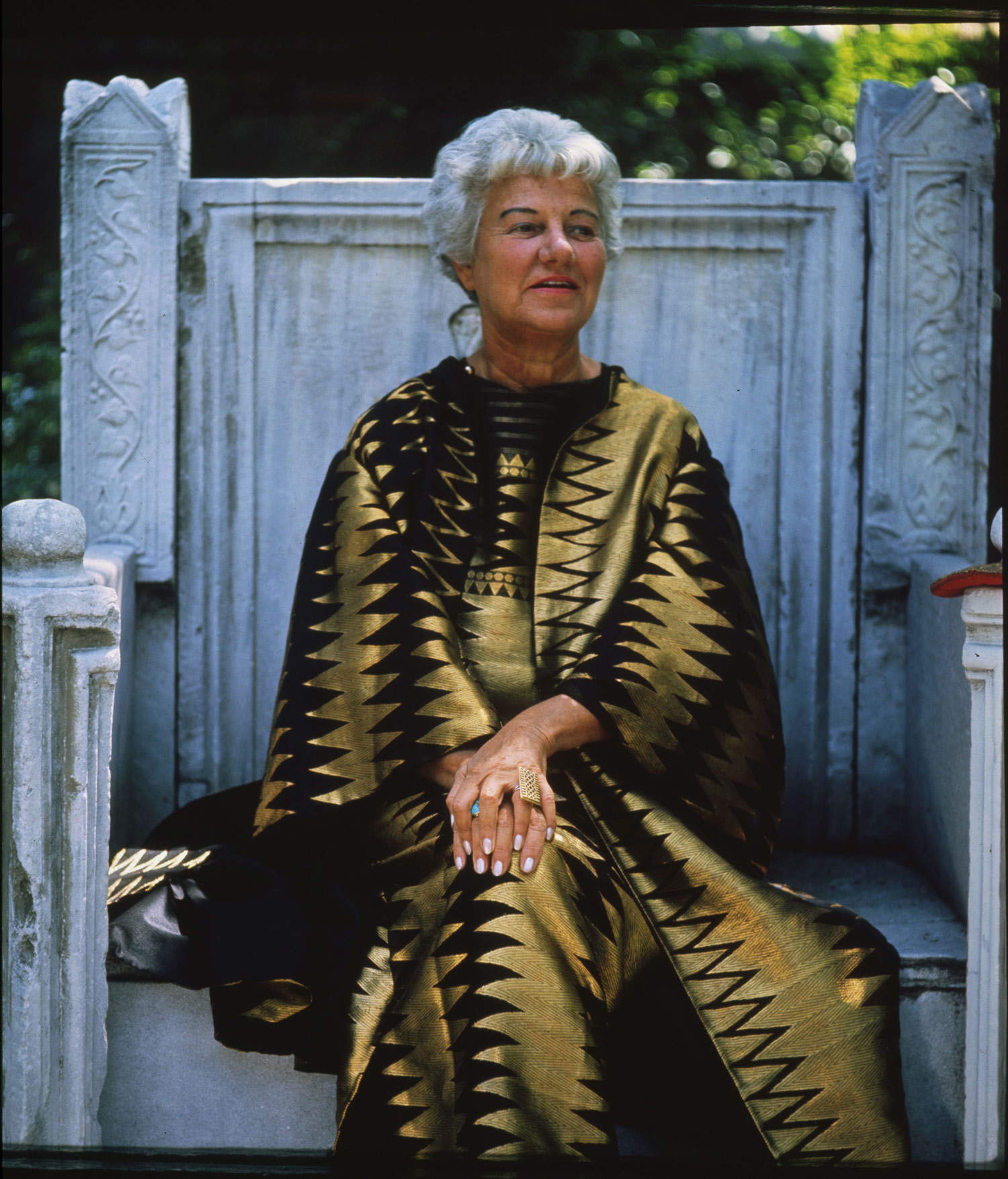
Peggy Guggenheim was very curious and an avid reader. When she did not know a subject she would delve deeper and read as many books as she could on that particular subject, author, or artist. She studied art history in depth and from a very young age began collecting her first works.
In the 1920s she married Laurence Vail, an American-born French painter, sculptor, writer and poet, with whom she moved to Paris, where she lived for a long time. With Vail, nicknamed the “King of the Bohemians,” she leads a completely different life from that of her family of origin in America: a free and casual life of travel, cocktails, splendid parties, fine wines, champagne and French chefs. It is her husband who introduces her to Parisian artistic circles, where she has the opportunity to meet numerous intellectuals and artists, with some of whom she will forge unbreakable bonds. She met Man Ray, an American artist, who at that time began to be known as a portrait and fashion photographer, working with some of the greatest fashion designers of the early 20th century, as well as for a number of prominent magazines such as Vogue and Vanity Fair. In 1924, the artist produced a portrait photograph of Peggy Guggenheim, who, at a party at her home on Boulevard Saint Germain, wears a gold evening dress, made especially for her by fashion designer and costume designer Paul Poiret, with a special hairstyle by Vera Stravinsky, an American artist and dancer, best known as the second wife of Russian musician Igor Stravinsky. The portrait is emblematic and representative: the Guggenheim is totally immersed in art, surrounded by artists, stylists, musicians and dancers, a vibrant atmosphere where complicity is palpable.

Several years later, after the end of her marriage, Peggy Guggenheim embarks on a great love affair with the English literary critic John Holms, with whom she will live until his untimely death. During this period she had the opportunity to meet many literary figures of the time, such as James Joyces and Samuel Beckett.
After a long period spent among great loves, overwhelming passions and fleeting adventures, she found herself alone and, at first almost as a joke, decided to open an art gallery in London, the ’Guggenheim Jeune’ that would be a beacon for the avant-garde movements of the time, promoting local and international artists. Peggy Guggenheim felt she knew little about modern art, and guided by her artist friend Marcel Duchamp, who instructed her in abstractionism and surrealism, she devoted her opening exhibition to a monograph of the writer, poet, screenwriter and painter Jean Cocteau. The gallery on Cork Street would remain active for several months, from January 1938 to June 1939, hosting more than twenty memorable exhibitions featuring some of the greatest names in twentieth-century art. It opened Vasily Kandinsky’s first solo exhibition in London, a sculpture exhibition with Constantin Brâncuși and Alexander Calder, an exhibition devoted to collage, and solo and group shows by many other artists including Yves Tanguy, Piet Mondrian, Salvador Dalí, and Henry Moore.
The Guggenheim continues to invest more and more of its assets in art. To support the artists and not disappoint them, in case no work sold, he bought a work at the end of each exhibition and soon his motto became, “buy a painting a day.” Following this principle, he begins to build what will become one of the most important art collections in the world. He buys works by young artists who were his contemporaries, who partly thanks to his support, would become internationally renowned figures over the years and whose works today find a place in the world’s most prestigious museums.
Thanks to his personality and charm, he managed to forge a strong bond with many of the artists with whom he collaborated, repeatedly commissioning not only works of art, but also design objects and architecture. In 1939 the French artist Tanguy made two earrings for her with pearls and shells painted in oil, with surreal landscapes in shades of pink. She, enthusiastic, wears them immediately, but one of them is ruined by the still fresh paint, thus forcing the artist to make another one but in blue, because she wanted to have two different ones.
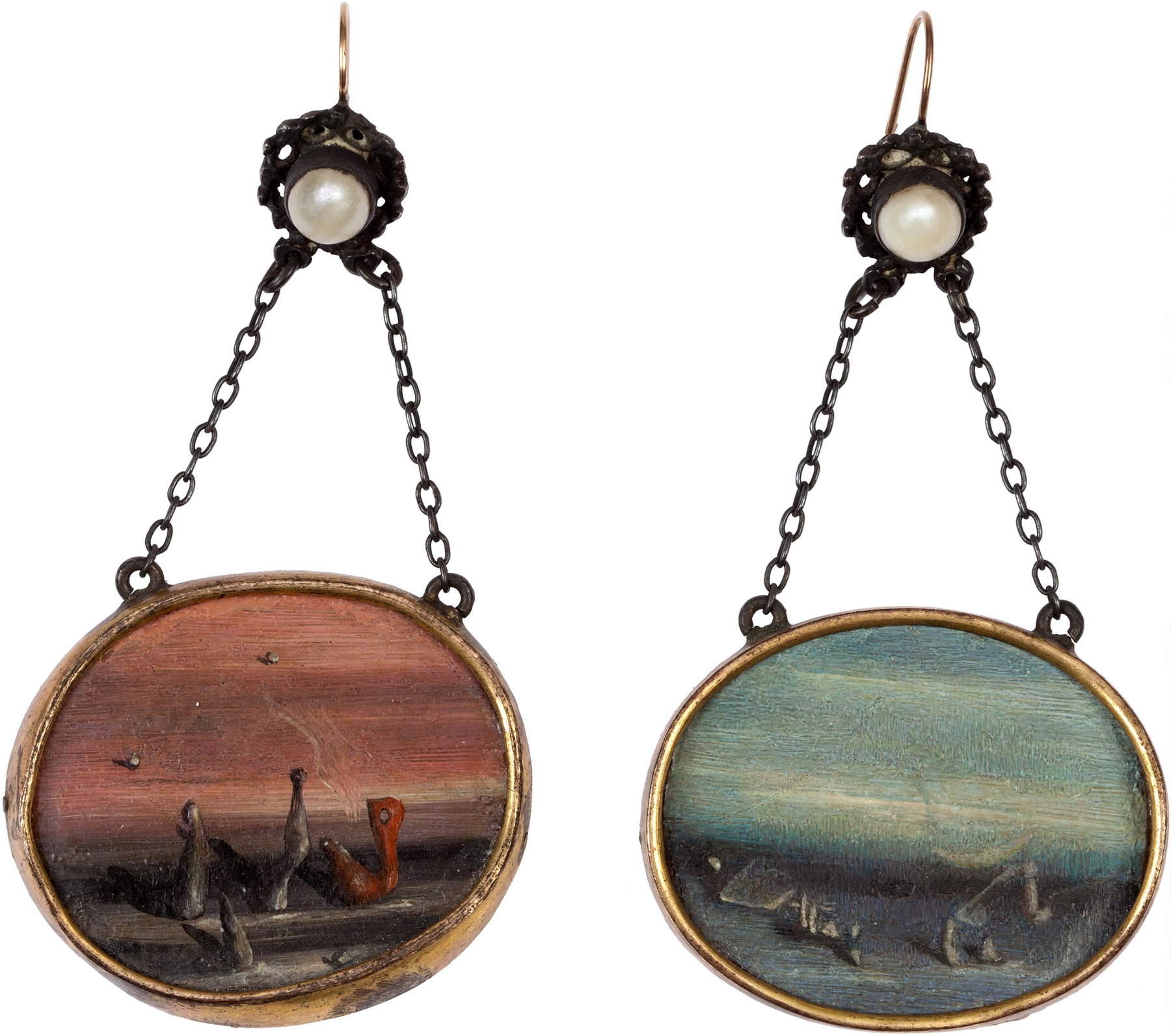
During the war she returned, with Max Ernst her future second husband, to New York where in 1942 she opened the art gallery ’Art of this Century,’ designed by Frederick Kiesler, a multifaceted artist, sculptor, architect and designer, best known for his utopian designs, whom she considered an unrecognized genius. Her only condition for him is to have paintings without frames, and for the rest Kiesler has ’carte blanche,’ creating an unconventional art gallery with a revolutionary layout. One room with curved walls made of rubberwood, where the paintings are set apart from the walls, supported one by one by wooden supports that can give different angles. Another room in which the walls are covered by a navy blue curtain and the paintings are suspended on ropes stretched from the ceiling to the floor.
The position of the paintings detached from the walls brings the paintings closer to the viewer by making them float in the air and become an integral part of the gallery’s architecture. The lights in the rooms turn on and off, illuminating first one part of the gallery and then the other, generating awe in visitors. The arrangement creates unity between art and architecture, between art and viewer.
Kiesler also designs the gallery seating, which can be used for many different purposes: rocking chair, easel for paintings, base for sculptures, or even bench or even table. The architect also proposes a new method of viewing works of art: the Vision Machine, a rotating table top that was to be used to both store paintings and display them, first pioneered at Marcel Duchamp’s exhibition. The viewer looking through a small opening in the wall would turn a large wheel that allowed numerous paintings to be viewed in succession.
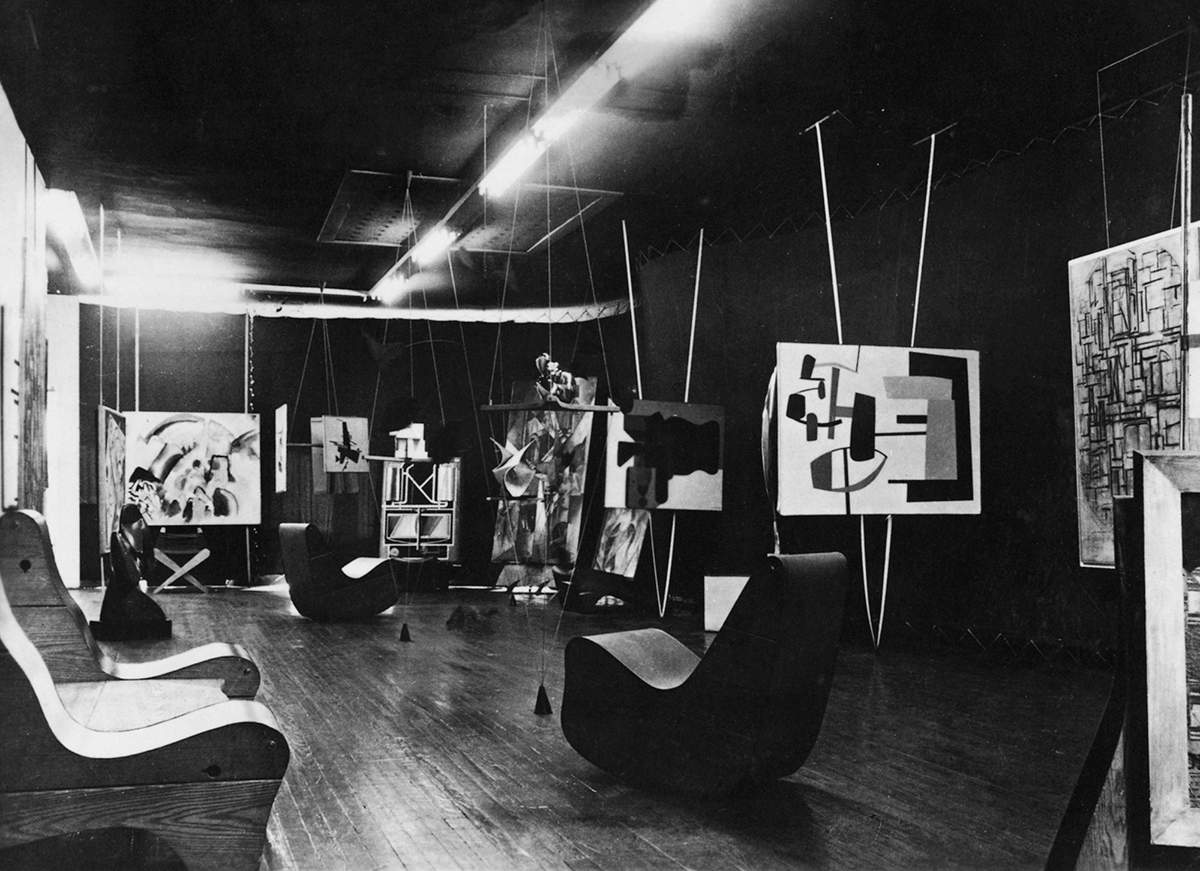
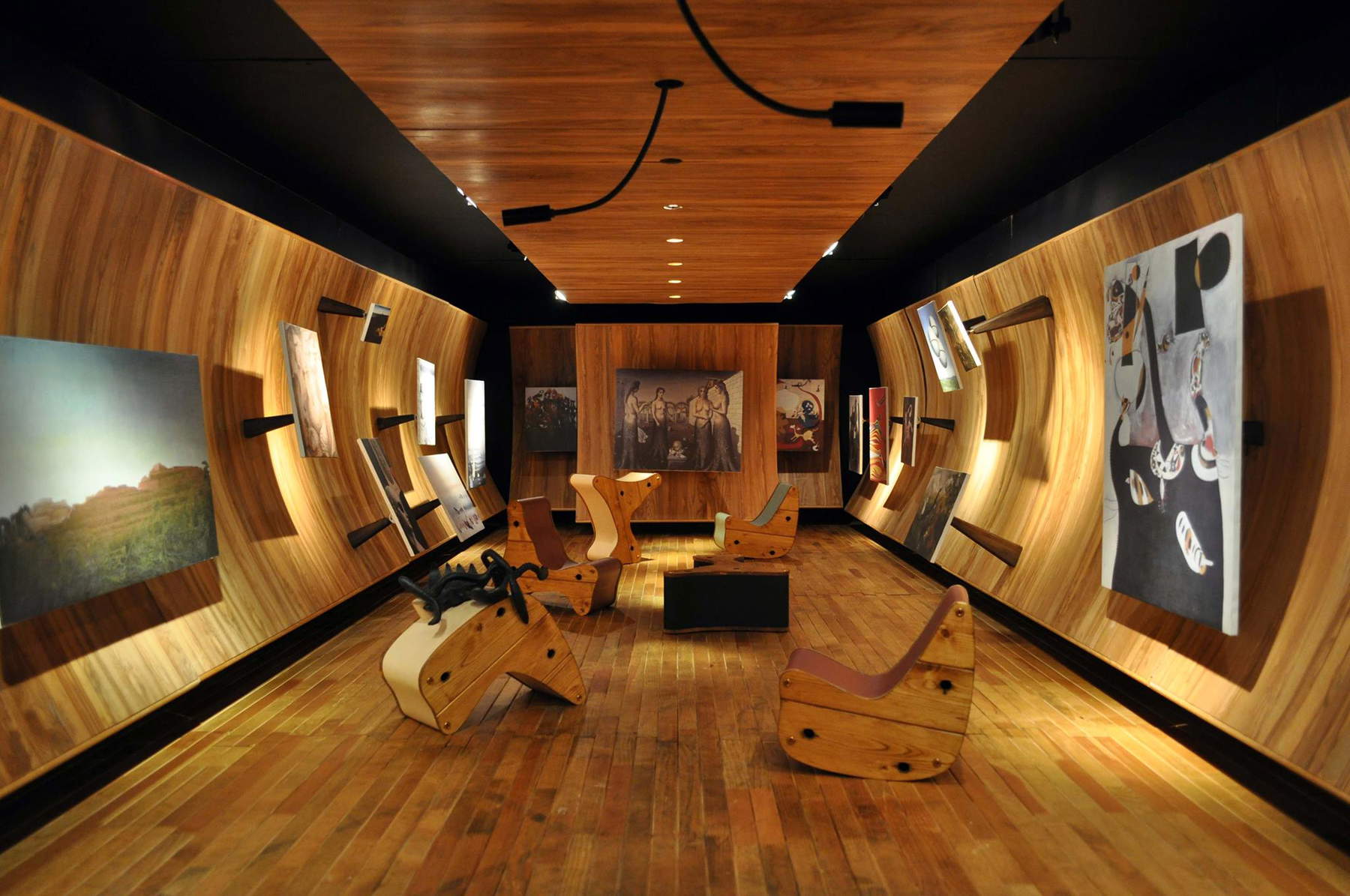
The gallery explored new possibilities for exhibition designs and became an architectural masterpiece and a landmark for contemporary art in New York as a launching pad for young artists, which Peggy Guggenheim would also promote in the future. At the first opening, on October 20, 1942, Peggy Guggenheim will wear an earring by Yves Tanguy and another by Alexander Calder, to demonstrate her impartiality between surrealists and abstractionists.
Around this time she asked Calder to make her a headboard for her bed: she wanted something different from the heavy brass one she inherited from her grandmother. So the artist made a work in silver, which, although very expensive, was the only material available because of the war, blending the world of the sea with the world of the garden, fish, insects and plants conveying the incessant movement of nature. Guggenheim loved this work because when she opened her bedroom window, the headboard moved with the wind, creating wonderful fairy-tale sounds. In her autobiography she wrote, "Not only am I the only woman in the world who sleeps in a Calder bed, but also the only woman to wear his huge mobiles earrings."

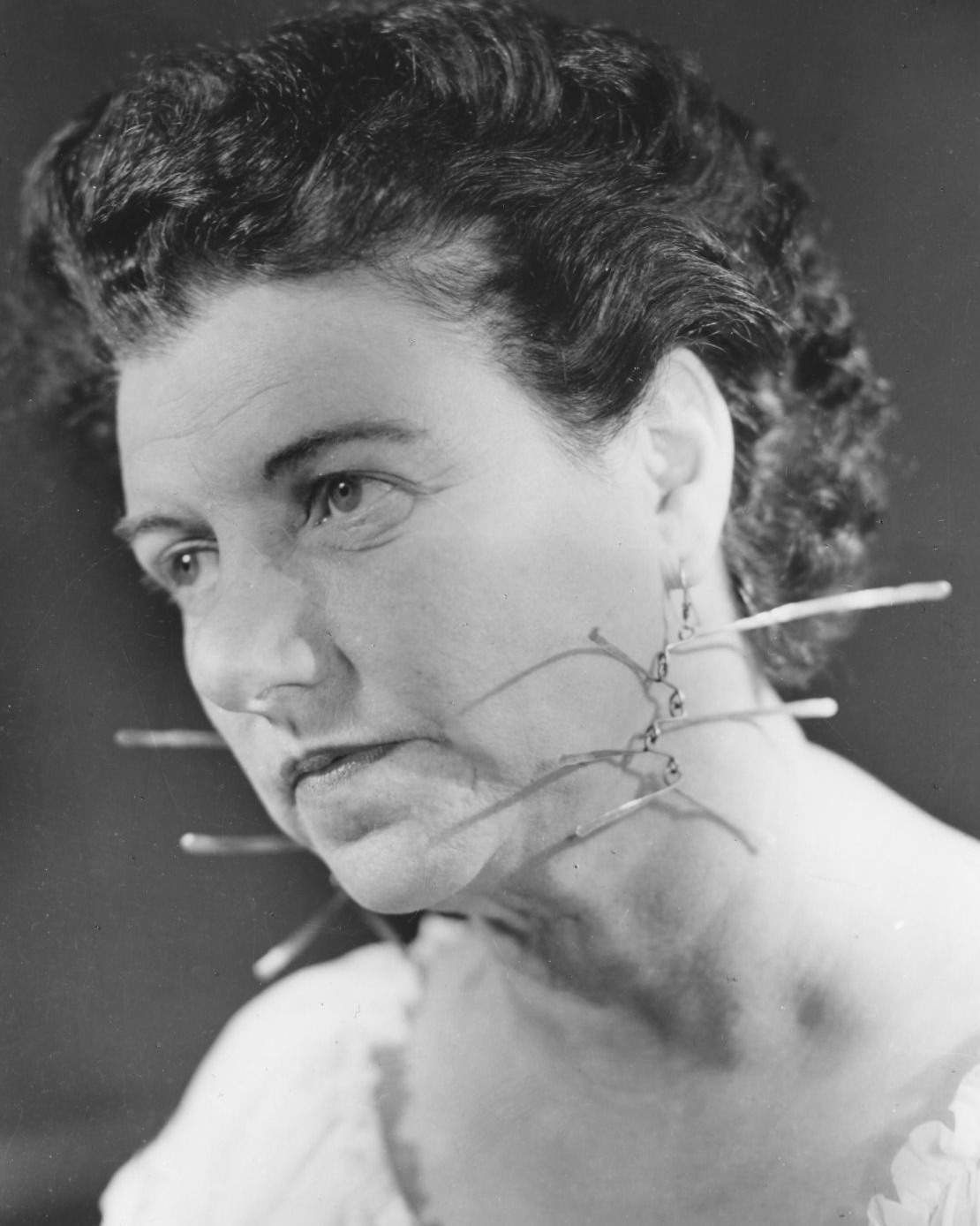

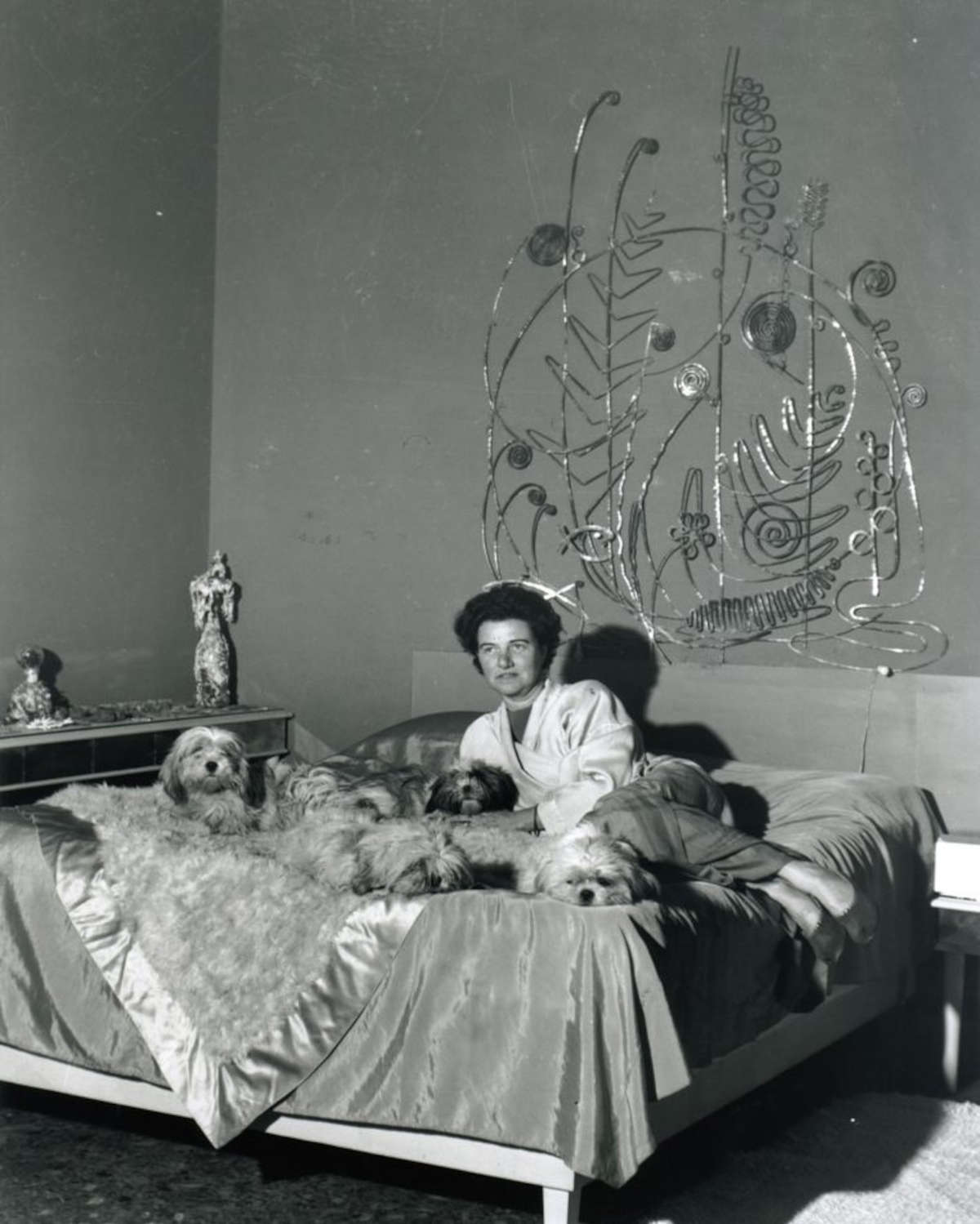
In 1948, the Venice Biennale devoted a pavilion to Peggy Guggenheim’s collection. Already long in love with this city, she later bought Palazzo Venier dei Leoni, an 18th-century building overlooking the Grand Canal, where she moved and lived permanently with her dogs and her works. Also in this city she collaborated with several artists from whom she commissioned objects made especially for her. In the 1950s the American artist Edward Malcarth, whose romantic images show the influence of Renaissance painters, designed Butterfly sunglasses for her, later reproduced in the 1990s by the Safilo company. In the early 1960s, American artist Claire Falkenstein, who developed her artistic expression based on the relationship between matter and space, made a gate with an aerial structure, a metal tangle, containing colored glass stones for Palazzo Vernier dei Leoni.
Peggy Guggenheim was able to challenge social conventions by transforming her life into a cultural and aesthetic mission. Through her courageous and nonconformist vision she gave artists a voice, building not just a collection but an idea of freedom, the result of a perfect harmony between art and design.
Warning: the translation into English of the original Italian article was created using automatic tools. We undertake to review all articles, but we do not guarantee the total absence of inaccuracies in the translation due to the program. You can find the original by clicking on the ITA button. If you find any mistake,please contact us.